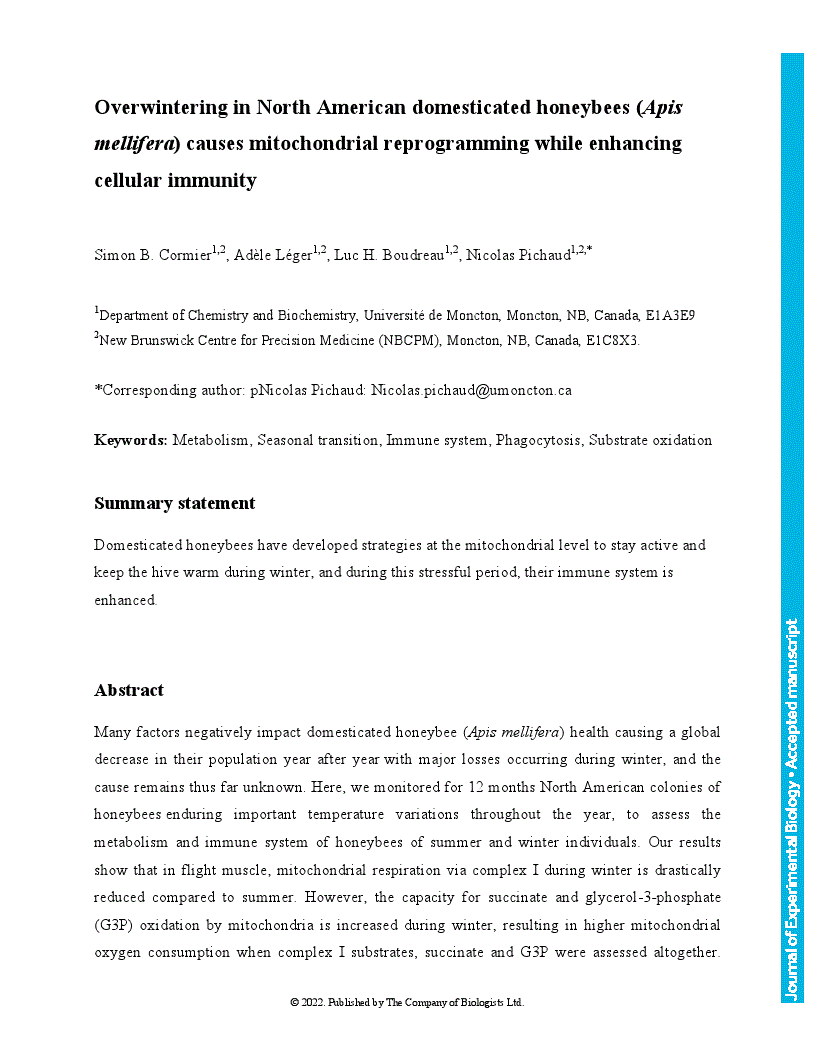Many factors negatively impact domesticated honeybee (Apis mellifera) health causing a global decrease in their population year after year with major losses occurring during winter, and the cause remains thus far unknown. Here, we monitored for 12 months North American colonies of honeybees enduring important temperature variations throughout the year, to assess the metabolism and immune system of honeybees of summer and winter individuals. Our results show that in flight muscle, mitochondrial respiration via complex I during winter is drastically reduced compared to summer. However, the capacity for succinate and glycerol-3-phosphate (G3P) oxidation by mitochondria is increased during winter, resulting in higher mitochondrial oxygen consumption when complex I substrates, succinate and G3P were assessed altogether. Pyruvate kinase, lactate dehydrogenase, aspartate aminotransferase, citrate synthase and malate dehydrogenase tend to have reduced activity levels in winter unlike hexokinase, NADH dehydrogenase and pyruvate dehydrogenase. Transcript abundance of highly important immunity proteins like Vitellogenin and Defensin-1 were also increased in winter bees, and a stronger phagocytic response as well as a better hemocyte viability was observed during winter. Thus, a reorganization of substrate utilization favoring succinate and G3P while negatively affecting complex I of the ETS is occurring during winter. We suggest that this might be due to complex I transitioning to a dormant conformation through post-translational modification. Winter bees also have an increased response for antibacterial elimination in honeybees. Overall, this study highlights previously unknown cellular mechanisms between summer and winter honeybees that further our knowledge about this important species.
Overwintering in North American domesticated honeybees (Apis mellifera) causes mitochondrial reprogramming while enhancing cellular immunity
- Award Group:
- Funder(s): Natural Sciences and Engineering Research Council of Canada
- Award Id(s): RGPIN-2017-05100
- Funder(s):
- Award Group:
- Funder(s): New Brunswick Innovation Foundation
- Funder(s):
Currently Viewing Accepted Manuscript - Newer Version Available
- Split-screen
- Views Icon Views
- Open the PDF for in another window
-
Article Versions Icon
Versions
- Version of Record 23 August 2022
- Accepted Manuscript 08 August 2022
- Share Icon Share
-
Tools Icon
Tools
- Search Site
Simon B. Cormier, Adèle Léger, Luc H. Boudreau, Nicolas Pichaud; Overwintering in North American domesticated honeybees (Apis mellifera) causes mitochondrial reprogramming while enhancing cellular immunity. J Exp Biol 2022; jeb.244440. doi: https://doi.org/10.1242/jeb.244440
Download citation file:
Advertisement
2023 JEB Outstanding Paper Prize shortlist and winner

The JEB Editors are delighted to announce the shortlisted authors for the 2023 JEB Outstanding Paper Prize. Read the winning paper - Tiny spies: mosquito antennae are sensitive sensors for eavesdropping on frog calls - by Hoover Pantoja-Sanchez and Brian Leavell from Ximena Bernal's lab at Purdue University, USA.
JEB Science Communication Workshop for ECRs

If you’re an early-career researcher interested in science communication and are attending the SEB Annual Conference in Prague this summer, come a day early and join the JEB Editors at a sci comm workshop to learn the key writing skills needed to promote your research to a broad audience beyond your peers (1 July at 14.30-17.30). Places are limited to 24 attendees, and applicants should apply through the SEB registration page by 30 April 2024.
Bridging the gap between controlled conditions and natural habitats in understanding behaviour

Novel technologies enable behavioural experiments with non-model species, in naturalistic habitats and with underexplored behaviours. In their Commentary, Scholz and colleagues discuss how to obtain a deeper understanding of the natural ecology and lifestyle of study animals.
Beluga metabolic measures could help save species

To help save animals from extinction, it’s important to understand what each species needs to survive. This led Jason John et al. to measure the metabolic rates of captive belugas to develop a ‘fish calculator’ showing that the whales need to eat ~23 salmon per day.
ECR Workshop on Positive Peer Review

Are you an ECR looking for tips on how to write concise, astute and useful manuscript reviews? If so, join the JEB Editors at a 2-hour JEB-sponsored Workshop on Positive Peer Review at the Canadian Society of Zoologists annual meeting in Moncton on 9 May 2024 at 13.00-15.00. There are 25 spaces for ECRs and selection is first come, first serve. To sign up, check the ECR Workshop box when you register for the CSZ meeting.



